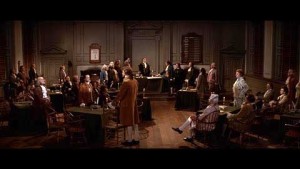
1776, Columbia Pictures‘ exuberant 1972 film adaptation of the Tony Award-winning Broadway musical, is now available on Blu-ray, from Sony Pictures Home Entertainment, in the form of a 4K digital restoration. Prepared under the guidance Peter H. Hunt, director, and Grover Crisp, executive VP of asset management, film restoration and digital mastering at Sony Pictures Entertainment, the new Director’s Cut restores the film to its original splendor and includes newly discovered material. It also features a restored and remixed 5.1 soundtrack. The restored 1776 made its world premiere screening March 28 at the TCM Classic Film Festival and is being released theatrically through Sony Pictures Repertory.
An imaginative look at the behind-the-scenes drama that led to the signing of the Declaration of Independence, the stage version of 1776 won Tony and New York Drama Critics Circle awards for best musical. Brought to the screen by legendary producer Jack L. Warner, the movie version featured most of the original Broadway cast, including stars William Daniels and Ken Howard, and much of its theatrical flair.
“The movie is not a ‘whodunit’ — we all know who signed the Declaration of Independence — it’s a ‘howdunit,'” observed Hunt. “It creates dramatic tension from a story where everyone knows the ending.”
The Director’s Cut is based, in part, on an earlier restoration carried out in 2002 for a DVD release. That version, also prepared with Hunt’s oversight, added a number of scenes and lost elements that weren’t in the original theatrical release. Among them was a musical number that had been dropped from the film by Warner at the request of President Richard Nixon, who felt the scene cast conservatives in an unfavorable light.
[huge_it_gallery id=”7″]
Further detective work for the new version uncovered additional “lost” material, including dialogue that had been changed over ratings concerns. “There were a few lines that Jack Warner wanted changed, but the changes weren’t funny,” said Hunt. “The original lines from Broadway were funny and now, for the first time, they are in the movie.”
For the new restoration, the original camera negative was scanned at 4K. That was followed by painstaking digital image restoration at Prasad Group and complete re-mastering and color grading at Colorworks, all of it completed at 4K resolution. Sound restoration and remixing were completed at Chace Audio.
State-of-the-art 4K digital technology made it possible to address problems and restore color fidelity to a level not possible at the time of the earlier restoration, which was done through photochemical processes. Variations in color, due to different levels of degradation in negative elements, have been eliminated as much as possible, resulting in a seamless look. “When a scene comes up that had been cut out or compromised in some way, it looks like it is supposed to be there because we could maintain consistency with the image and keep it’s natural filmic quality,” explained Crisp.
[huge_it_gallery id=”8″]
Colorworks colorist Sheri Eisenberg said that much time was spent studying existing film prints and other reference material to ensure the restoration accurately represented the movie in its original form. “We did a lot of eyeballing,” she said. “We kept asking ourselves, ‘Does it feel right?’ ‘What can we do to make it better?’ We wanted to keep the theatrical feeling of the original.”
Hunt said that, in some ways, the results go beyond the original. “I’m ecstatic,” he said. “1776 is back to where it should be. The work done by Grover and his team is miraculous. It looks better than when it premiered. It’s gorgeous!”





